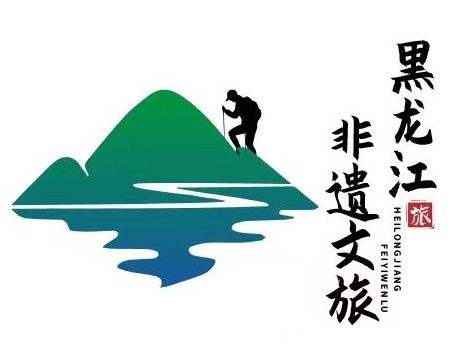赫哲族鱼皮制作工艺
Hezhen Fish Skin Processing Technique
非遗级别:国家级 Intangible cultural heritage level: National
批准时间:2006年5月20日 Approval Date: May 20th, 2006
类别:传统技艺 Category: Traditional Crafts
申报地区:黑龙江省的饶河、抚远两县
Application Region: Raohe County and Fuyuan County in Heilongjiang Province
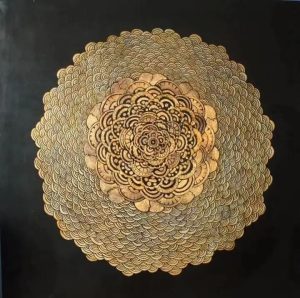 饶河县,隶属于黑龙江省双鸭山市,位于黑龙江省东北边陲。全县共有27个民族,有1个赫哲族乡和3个朝鲜族村,有饶河岛、大佳河保护区、大顶子山风景区、乌苏里江等著名景点。
饶河县,隶属于黑龙江省双鸭山市,位于黑龙江省东北边陲。全县共有27个民族,有1个赫哲族乡和3个朝鲜族村,有饶河岛、大佳河保护区、大顶子山风景区、乌苏里江等著名景点。
Raohe County belongs to Shuangyashan City, which is located on the northeast border of Heilongjiang Province. There are 27 ethnic groups, 1 Hezhen Village and 3 Korean hamlets in the county, as well as famous tourist attractions like Raohe Island, Dajia River Reserve, Dadingzi Mountain Scenic Spot and the Wusuli River.

抚远市地处黑龙江省东北部,黑龙江、乌苏里江交汇的三角地带。抚远是中国陆地最东端的县,是最早将太阳迎进祖国的地方,素有“东方第一城”之美誉,境内有黑瞎子岛,抓吉赫哲族民俗村等旅游景点。Fuyuan County is located in the northeast of Heilongjiang Province, the triangle zone where Heilongjiang River and the Wusuli River meet. Fuyuan County is the easternmost part of China, the first place to receive the sun shining on the motherland, and is hailed as “the Top County of the Orient”. There are Heixiazi Island, Zhuaji Folk Village of Hezhen people and other tourist attractions in this county.
PART 1 历史渊源 Historical Origin
赫哲族主要分布在黑龙江省的饶河、抚远两县,沿江而居的赫哲人仍以渔业为主,他们捕鱼、食鱼、用鱼皮盖房、造舟、制衣。鱼皮制品以北方冷水鱼的鱼皮为原料,冷水鱼皮质有一定的厚度和韧性,比较耐磨,便于在生产生活中使用。鱼皮文化历史悠久,虽然历史上众多民族都曾有过鱼皮文化,但从清代开始只有黑龙江省同江市街津口乡的赫哲族将之传承沿袭下来。Hezhen people are mainly distributed in Raohe County and Fuyuan County in Heilongjiang Province. Living along the river, Hezhen people mainly live by fishing—they catch fish, eat fish, and use fish skins to build houses, build skiffs and make clothes. Fish-skin products are made from the skin of northern cold water fish. Its skin has certain thickness and toughness, which is relatively wear-resistant and suitable to use in production and daily life. Fish skin culture has a long history. Although many ethnic groups have had fish skin cultures in history, only the Hezhen people in Jiejinkou Village, Tongjiang City, Heilongjiang Province have inherited it since the Qin Dynasty.
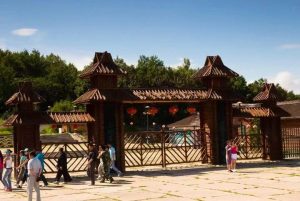
PART 2 工艺流程 Processing Technique
 赫哲人及其先民在长期生活实践中积累了丰富的经验,根据鱼皮的厚薄、软硬等使用特性制作不同的衣物和器具。The Hezhen people and their ancestors have accumulated rich experience in long-term living practice, making different clothes and utensils based on the thickness, softness, and hardness of fish skin.
赫哲人及其先民在长期生活实践中积累了丰富的经验,根据鱼皮的厚薄、软硬等使用特性制作不同的衣物和器具。The Hezhen people and their ancestors have accumulated rich experience in long-term living practice, making different clothes and utensils based on the thickness, softness, and hardness of fish skin.
赫哲人及其先民在长期生活实践中积累了丰富的经验,根据鱼皮的厚薄、软硬等使用特性制作不同的衣物和器具。The Hezhen people and their ancestors have accumulated rich experience in long-term living practice, making different clothes and utensils based on the thickness, softness, and hardness of fish skin.
赫哲人及其先民在长期生活实践中积累了丰富的经验,根据鱼皮的厚薄、软硬等使用特性制作不同的衣物和器具。The Hezhen people and their ancestors have accumulated rich experience in long-term living practice, making different clothes and utensils based on the thickness, softness, and hardness of fish skin.
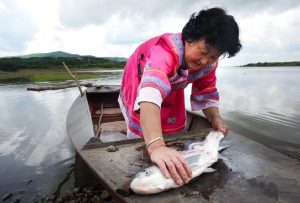 将整条不刮鳞的鱼,先用刃器(木制小刀等,现代多用钢刀)在头身相接处横向划一周,再顺鱼腹竖向划剥。Use a sharp tool (such as previous wooden knife or modern steel knife) to horizontally cut the entire unscaled fish around the joint between its head and body, and then vertically peel it along the belly.
晾干鱼皮,早年是把剥下来的整张鱼木钉钉在屋内墙上,阴干若干日,使其脱水在火堆旁烘干。后来人们常常将鱼皮贴到仓房围墙的阴凉通风处晾干。In the early years, the entire piece of fish skin was nailed to the interior wall with a wooden peg. It would be dehydrated in the shade for several days, and then dried by the fire. Nowagdays, people often paste the fish skin in a cool and ventilated area of the warehouse wall for dehydration.
人们将晾干的一张鱼皮叠放在木砧上,用木棒或木槌或木斧捶打。捶打过程中鱼鳞自然脱落,鱼皮逐渐变软。People place a folded piece of dried fish skin on a wooden board and beat it with a wooden stick, wooden mallet, or wooden axe. During the beating process, the fish scales naturally fall off and the skin gradually softens.
将整条不刮鳞的鱼,先用刃器(木制小刀等,现代多用钢刀)在头身相接处横向划一周,再顺鱼腹竖向划剥。Use a sharp tool (such as previous wooden knife or modern steel knife) to horizontally cut the entire unscaled fish around the joint between its head and body, and then vertically peel it along the belly.
晾干鱼皮,早年是把剥下来的整张鱼木钉钉在屋内墙上,阴干若干日,使其脱水在火堆旁烘干。后来人们常常将鱼皮贴到仓房围墙的阴凉通风处晾干。In the early years, the entire piece of fish skin was nailed to the interior wall with a wooden peg. It would be dehydrated in the shade for several days, and then dried by the fire. Nowagdays, people often paste the fish skin in a cool and ventilated area of the warehouse wall for dehydration.
人们将晾干的一张鱼皮叠放在木砧上,用木棒或木槌或木斧捶打。捶打过程中鱼鳞自然脱落,鱼皮逐渐变软。People place a folded piece of dried fish skin on a wooden board and beat it with a wooden stick, wooden mallet, or wooden axe. During the beating process, the fish scales naturally fall off and the skin gradually softens.
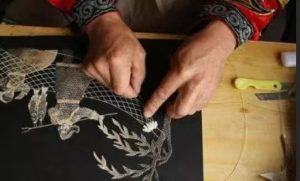 熟好的鱼皮即可剪裁和拼缝了。拼缝前,先用刮皮刀将熟好的鱼皮上的杂乱纤维刮干净;将不整齐的边角剪掉;将鱼鳍部位的开缝缝连起来The softened fish skin can be cut and stitched. Before stitching, a beam knife should be used to scrape off the messy fibers on the softened fish skin. Then, Hezhen people will cut off its irregular edges. Finally, the smooth fish skins of regular shapes are sewed toghter into bigger ones.
定型:定型就是鱼皮服装的艺术加工。鱼皮服装制作的最后一道工序是艺术加工, 分染色和装饰。It means the artistic processing of fish-skin clothing, the final processing of fish skins which involves dyeing and decorating.
熟好的鱼皮即可剪裁和拼缝了。拼缝前,先用刮皮刀将熟好的鱼皮上的杂乱纤维刮干净;将不整齐的边角剪掉;将鱼鳍部位的开缝缝连起来The softened fish skin can be cut and stitched. Before stitching, a beam knife should be used to scrape off the messy fibers on the softened fish skin. Then, Hezhen people will cut off its irregular edges. Finally, the smooth fish skins of regular shapes are sewed toghter into bigger ones.
定型:定型就是鱼皮服装的艺术加工。鱼皮服装制作的最后一道工序是艺术加工, 分染色和装饰。It means the artistic processing of fish-skin clothing, the final processing of fish skins which involves dyeing and decorating.
PART 3 传承现状 Inheritance status
由于博物馆收藏和人类文化学研究的需要,老一代赫哲人曾多次为国内外博物馆复制鱼皮服饰,使这一技艺在局部地区得到传承。老艺人还用传统技艺创制了鱼皮萨满服饰及赫哲风俗系列作品,一些年轻人发展创新,利用传统的鱼皮剪贴技术创制了现代的鱼皮技艺品及鱼皮画,使古老的鱼皮文化延伸到旅游、艺术等领域。Due to the needs of museum collection and ethnology research, the older generation in Hezhen people has replicated fish-skin clothing for domestic and foreign museums for many a time, making it possible that this traditional technique can be inherited and passed down in some areas. Additionally, old artists also used traditional technique to create a series of shaman1 fish-skin costumes and Hezhen customs works, and young generation innovatively used the traditional technique to create modern fish-skin clip art, extending the ancient fish-skin culture to tourism, art, and other fields.
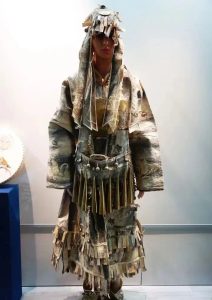
PART 4 传承价值 Inheritance value
鱼皮制作技艺是赫哲族一种独特的渔猎文化,是赫哲民族历史发展的缩影,也是中国优秀传统文化的重要组成部分。目前掌握传统鱼皮技艺的老人多已离世,鉴于古老的赫哲族鱼皮制作技艺濒临消亡,亟待予以抢救与保护。
Fish skin processing technique is a unique fishing and hunting culture of the Hezhen Nationality. It is also a microcosm of the historical development of the Hezhen Nationality, and a significant part of Chinese excellent traditional culture. At present, since many Hezhen craftsmen have passed away, this traditional technique is on the verge of extinction. Therefore, it is of great urgency to conserve it.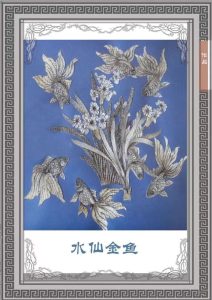
 饶河县,隶属于黑龙江省双鸭山市,位于黑龙江省东北边陲。全县共有27个民族,有1个赫哲族乡和3个朝鲜族村,有饶河岛、大佳河保护区、大顶子山风景区、乌苏里江等著名景点。
饶河县,隶属于黑龙江省双鸭山市,位于黑龙江省东北边陲。全县共有27个民族,有1个赫哲族乡和3个朝鲜族村,有饶河岛、大佳河保护区、大顶子山风景区、乌苏里江等著名景点。
 赫哲人及其先民在长期生活实践中积累了丰富的经验,根据鱼皮的厚薄、软硬等使用特性制作不同的衣物和器具。The Hezhen people and their ancestors have accumulated rich experience in long-term living practice, making different clothes and utensils based on the thickness, softness, and hardness of fish skin.
赫哲人及其先民在长期生活实践中积累了丰富的经验,根据鱼皮的厚薄、软硬等使用特性制作不同的衣物和器具。The Hezhen people and their ancestors have accumulated rich experience in long-term living practice, making different clothes and utensils based on the thickness, softness, and hardness of fish skin. 将整条不刮鳞的鱼,先用刃器(木制小刀等,现代多用钢刀)在头身相接处横向划一周,再顺鱼腹竖向划剥。Use a sharp tool (such as previous wooden knife or modern steel knife) to horizontally cut the entire unscaled fish around the joint between its head and body, and then vertically peel it along the belly.
将整条不刮鳞的鱼,先用刃器(木制小刀等,现代多用钢刀)在头身相接处横向划一周,再顺鱼腹竖向划剥。Use a sharp tool (such as previous wooden knife or modern steel knife) to horizontally cut the entire unscaled fish around the joint between its head and body, and then vertically peel it along the belly. 熟好的鱼皮即可剪裁和拼缝了。拼缝前,先用刮皮刀将熟好的鱼皮上的杂乱纤维刮干净;将不整齐的边角剪掉;将鱼鳍部位的开缝缝连起来The softened fish skin can be cut and stitched. Before stitching, a beam knife should be used to scrape off the messy fibers on the softened fish skin. Then, Hezhen people will cut off its irregular edges. Finally, the smooth fish skins of regular shapes are sewed toghter into bigger ones.
熟好的鱼皮即可剪裁和拼缝了。拼缝前,先用刮皮刀将熟好的鱼皮上的杂乱纤维刮干净;将不整齐的边角剪掉;将鱼鳍部位的开缝缝连起来The softened fish skin can be cut and stitched. Before stitching, a beam knife should be used to scrape off the messy fibers on the softened fish skin. Then, Hezhen people will cut off its irregular edges. Finally, the smooth fish skins of regular shapes are sewed toghter into bigger ones.
